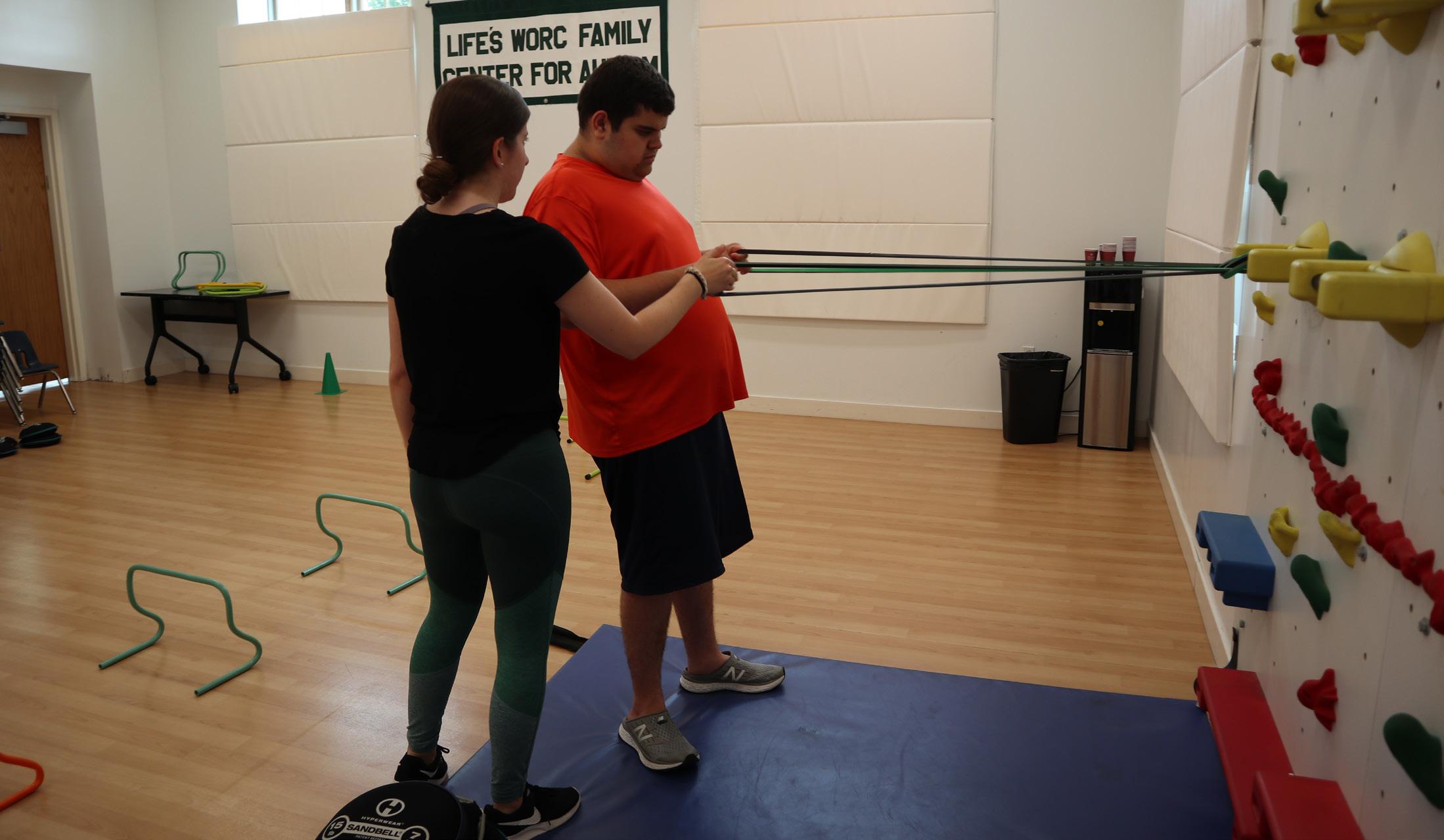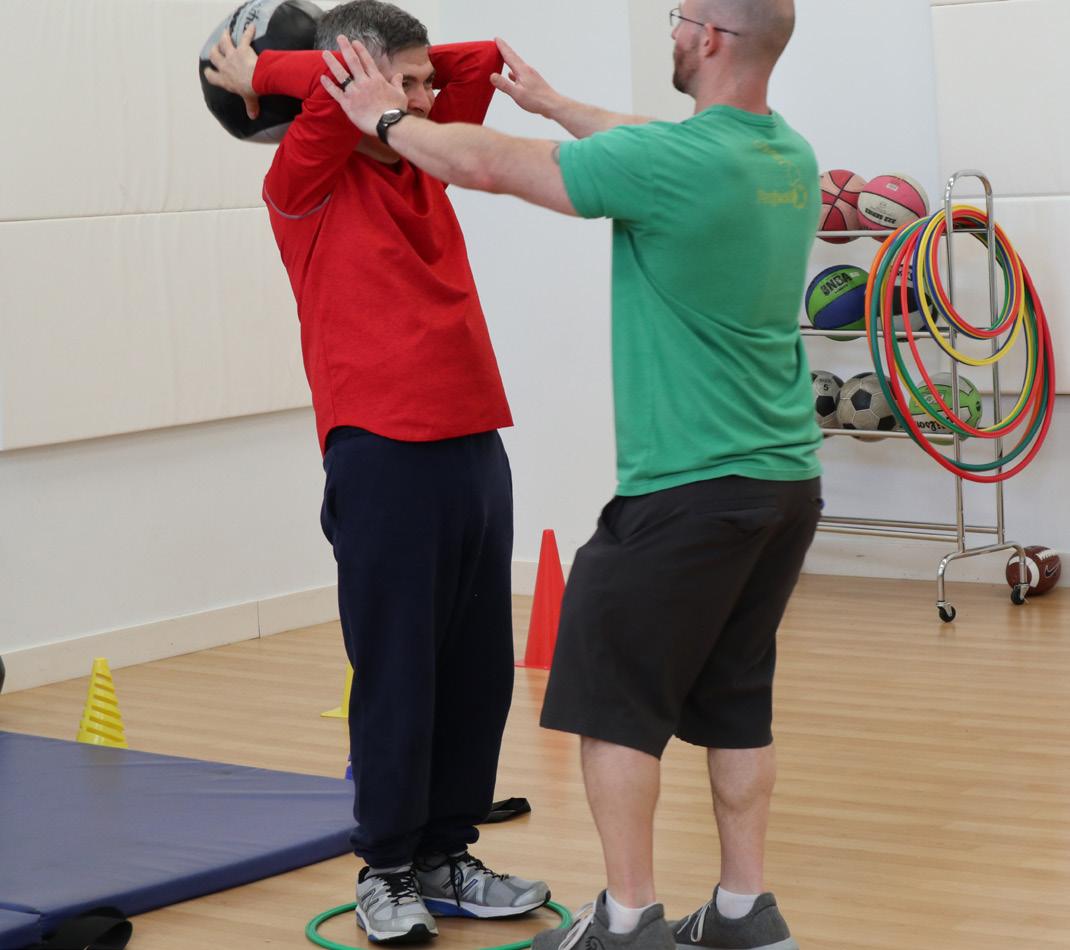
7 minute read
FITNESS ANYWHERE: EXCELLENT HOME-BASED PROGRAMS FOR THE SPECIAL NEEDS COMMUNITY
Avoiding mistake one: objects vs. objectives
By the time many families contact me, there is some variation of “We tried a treadmill/elliptical/some machine, and it didn’t go really well.” I applaud you for embarking on the fitness journey. The issue here is one we refer to as “objects vs. objectives.” Rather than work around a given piece of equipment (the treadmill), it is essential to consider what the individual needs in terms of exercise programming.
What are the needs?
Overwhelmingly, the most common movement issues among the special needs population, in addition to individuals with related developmental disabilities, include three categories: strength, stability, and motor planning.
Strength, stability, and motor planning
The strength and stability deficits are often diagnosed as “low tone,” which can inhibit everything from gait to carrying laundry or a garbage bag. Strength and stability deficits left alone may eventually lead to movement dysfunction and patterns that increase the likelihood of lower back pain and other issues in adulthood—situations it would obviously be best to avoid.
Motor planning is the transition from one movement pattern to another as efficiently as possible. Individuals on the autism spectrum and other special needs may have difficulty with tasks that require switching from one physical sequence to another, whether predominantly gross motor or fine motor.
Fitness is a life skill and should be considered and accounted for as such
Without a proper fitness program being implemented, individuals with developmental abilities are at the same, if not higher, as some research indicates, risk for medical complications that result from inactivity. These have direct consequences on quality of life and independence. If we begin focusing on these deficits and building skills now, we can greatly reduce persistent and chronic issues in the future.
So, what constitutes a “good” fitness program? How individualized does it need to be?
Well, here’s the thing; while everyone is different and needs vary, the reality is that fitness programming is remarkably similar with slight changes based on individual abilities.
In our Autism Fitness programming, all of our athletes perform basic, fundamental movement patterns that include hurdle steps, crawling patterns, squats, presses, heavy carries, and a variety of upper-body pulling exercises. The exercises remain constant. What changes are two variables that are absolutely necessary for successful programming.

Progressions and regressions
Exercise progressions increase the challenge of a particular exercise. Regressions decrease the difficulty level. Given the common strength and motor deficits we see in the ASD population, knowing how to regress an exercise is a main ingredient for programming.
We start where we start
How familiar are the terms “low functioning” and “high functioning”? Hear them often? So do I. How do they influence our fitness programming? Not much, or rather, not much until we ask more specific questions about them.
The PAC Profile Approach
Successful fitness programming for the special needs population requires knowing each individual’s three areas of ability: physical, adaptive, and cognitive.
1. Physical: At what level of challenge (progression/regression) will the individual be successful with the exercise?
2. Adaptive: How motivated is the individual to perform a particular exercise?
3. Cognitive: What level of coaching support does the individual need to learn this exercise?

Think of this as a filtration system. We’re filtering out answers about each ability to individualize programming. It’s not about having 50 different exercises, but about choosing a few and knowing what level of challenge will be the most appropriate.
Regressing an exercise and making it simpler could take a few different forms and will differ from one exercise to another. This is certainly not an all-or-nothing situation. We might have an individual who is independent with medicine ball push throws but needs a full physical prompt to safely perform an overhead press.

Get to the exercises!
The beginning of this article mentioned the word “practical,” didn’t it? With all of these considerations and qualities, there is still the question of “what exercises to use?” A bunch of exercises tossed together is not quite a program, so let’s look at the three phases of exercises we use in our programs:
1. Phase One/Warm-Up/Mobility: These are the exercises we use to get the body ready for more challenging activities. They prepare the muscles and joints for action. We use low hurdle steps, bear walks/crawls, cone touches, and overhead walks with a band. A lot of these exercises combine locomotion with hip and shoulder mobility and flexibility.
2. Phase Two/Dynamic Movement: Picking up the pace a bit, these exercises include developing power, stability, and reactive skills. Here we use our three medicine ball throws (push, overhead, and scoop) and rope swings.
3. Phase Three/Strength and Stability: This is where we spend the majority of our session time as these are the exercises that will have the greatest carryover or generalization to activities of daily living (ADLs). Here we use squats, presses, band rows, and pull-downs, along with heavy sandbag carries.
Programming at home
I’ll preface this by stating that I never give out program templates or programming suggestions unless I have a full video assessment of the individual. Again, we’re not just dealing with movement, but with the adaptive and cognitive considerations as well.
For starter home programs, choosing two to three exercises in each category is usually a reasonable plan. Below are links to video examples of Warm-Up, Dynamic Movement, and Strength/Stability exercises.
We start where we start. Keep that in mind. Exercise is a life skill, which means we have plenty of time to continue shaping and enhancing the physical skills for each individual. It’s all important, but it’s not an emergency. Consistency wins.
WARM-UP/MOBILITY
Exercise
Hurdle Steps
Cone Touches
Bear Walks or Crawls
Purpose
Sets/Repetitions
Gait and hip mobility 3-4/4-6 Hip flexion and motor planning Trunk and shoulder stability + hip mobility 3-4/4-6
3-5/5-6 forward walk or crawl
Video Link
https://youtu.be/WT2LLchw0NM
https://youtu.be/pOV7kJb3lGM
https://youtu.be/mrCYHVhowbM
DYNAMIC MOVEMENT
Exercise
Dynamax Ball Push Throws Dynamax Ball Overhead Throws Dynamax Ball Scoop Throws
Purpose
Lower body stability + upper body power Lower body stability + upper body power + thoracic mobility
Sets/Repetitions Video Link
2-3/6-10 https://youtu.be/0Q3uz0sAI_8
2-3/6-10 https://youtu.be/LCUTQWfDETE
Hip hinging + spinal stability 3-5/5-8 https://youtu.be/UEYS4r8AdhM
STRENGTH/STABILITY
Exercise
Standing Band Rows
Overhead Sandbell Presses Chest Carry
Purpose
Grip and pulling strength (upper body) Shoulder and trunk strength and stability Full body strength
Sets/Repetitions Video Link
3-4/8-10 https://youtu.be/_EfI1_ZLJhA
3-4/6-8
N/A https://youtu.be/QbaR_916Q6o
https://youtu.be/XgMgI5_6CPs
Eric Chessen, MS, is the founder of Autism Fitness. With extensive backgrounds in both exercise science and Applied Behavior Analysis (ABA), Eric developed the PAC Profile™ Approach, which is used by professionals and parents around the world. Eric is the creator and lead instructor for the Autism Fitness Certification and consults with professionals and parents who want to bring the best possible fitness and adapted physical education programs into the lives of the individuals they care for. He resides in Charlotte, NC, and is available for one-to-one programming.
Website: AutismFitness.com Email: Eric@AutismFitness.com
Engaging, Equipping, and Encouraging the Neuro-Distinct Autistic Adult

By J. David Hall, MDiv and Marcelle Ciampi, MEd
“TO THIS DAY, YEARS AFTER MY LATE-AGE DIAGNOSIS OF ASPERGER’S, I PONDER THE PROS AND CONS OF BEING OUT OF THE PROVERBIAL AUTISTIC CLOSET. FROM DARK TO DARK, IT SEEMS, SOME DAYS. THE LANTERN’S LIGHT OF THE INTERIOR IDEALIST LONGING DEEPLY FOR THE WHOLE OF THE WORD TO BE OUT AS TRANSPARENT HUMANS. THIS AUTISM, AS IT IS, THE MERGING INFANCY IN A REALM OF EMERGING NEURODIVERGENT MINORITIES. I WISH FOR THE SINGULAR CONDITION, A SINGULAR STATUS, COLOR, CREED, OR MARKER, TO MAKE WAY TO A RISING OF THE HOLISTIC HUMAN CONDITION. THE UNIQUE INDIVIDUALIZED, UNREFINED, AND UNIFIED PRESENTATION. LIFE TO BE LIVED TO THE BEST OF CAPACITY, IN AN OFTENTIMES CONFUSED WORLD, WHO CANNOT CEASE TO LET GO OF NORMALCY.”
—Marcelle Ciampi, Southwest Washington Autism Conference, Closing Keynote
Ihave some regrets in disclosing my autism some eight years ago. I harbor an internal discomfort in relation to some individuals knowing I have autism. Even as I am, an accomplished professional delivering keynotes and educational webinars to Fortune 500 companies, there remains a residue—a thin layer of separateness. Something I cannot seem to wash away. Admittedly, some makings are self-invented, assumptions on my part, intermittent second-guessing. As I am still learning to live in my own skin, despite what I think others think. Still unmasking. Still unpacking. I sometimes feel as the rough-edged shard, before the sea glass; the foreign element before defined; the colored-in sheep of black. A brokenness to be analyzed, dissected, tested upon, reprogrammed, reformed into something else: someone else.
An observer might assume, with my studies in communication and psychology, meaningful interpersonal interactions, and deemed accomplishments, that this interior ache of not being truly seen would dissipate. But it doesn’t. Primarily because some people can’t see past a label.










